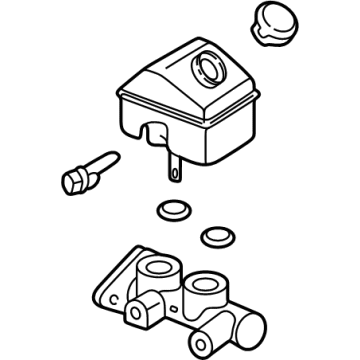My Garage
My Account
Cart
Genuine Saturn LS1 Brake Master Cylinder
- Select Vehicle by Model
- Select Vehicle by VIN
Select Vehicle by Model
orMake
Model
Year
Select Vehicle by VIN
For the most accurate results, select vehicle by your VIN (Vehicle Identification Number).
1 Brake Master Cylinder found
Saturn LS1 Brake Master Cylinder
The Brake Master Cylinder in automobiles such as Saturn LS1 is one of the significant parts of the brake system that perform the function of changing the pressure from the foot to the hydraulic pressure in order to control the slave cylinders. This system uses hydraulic fluid to communicate force created by master cylinder's piston to slave cylinders; increasing force and displacement. Standard equipments of the Saturn LS1 vehicles include Dual circuit master cylinders, which consist of two pistons whereby in the even that one circuit fails the other is capable of generating adequate pressure to bring the car to a halt. The master cylinder works the calipers for disc brake or drum brake to produce the friction needed to stop the wheels; the master cylinder also actuates the slave Cylinder to fractions the clutch. This will help to avoid hoes and leaks, corrosion, or several internal failures known to result in low pedal and poor stopping potential. It works to control hydraulic forces and forces exerted by pressures of Brake Master Cylinder guarantee braking and clutch mechanisms of the vehicle.
Each OEM Saturn LS1 Brake Master Cylinder we offer is competitively priced and comes with the assurance of the manufacturer's warranty for the part. Furthermore, we guarantee the speedy delivery of your orders right to your doorstep. Our hassle-free return policy is also in place for your peace of mind.
Saturn LS1 Brake Master Cylinder Parts Questions & Experts Answers
- Q: How do you remove the master cylinder on Saturn LS1?A: To remove the brake master cylinder, start by removing as much fluid as possible from the reservoir using a syringe or turkey baster. Place rags under the fluid fittings and prepare caps or plastic bags to cover the ends of the lines once they are disconnected. On manual transaxle models, disconnect the clutch master cylinder supply hose from the brake fluid reservoir. Loosen the fittings at the ends of the Brake Lines where they enter the brake master cylinder, using a flare-nut wrench to prevent rounding off the corners. Pull the brake lines slightly away from the brake master cylinder and plug the ends to prevent contamination. Disconnect the electrical connector at the brake fluid level switch on the brake master cylinder reservoir, then remove the nuts attaching the brake master cylinder to the power booster. Carefully pull the brake master cylinder off the studs and out of the engine compartment, being cautious not to spill any fluid. If installing a new brake master cylinder, unclip the reservoir mounting tabs and transfer the reservoir to the new brake master cylinder. To install the new brake master cylinder, bench bleed it first by mounting it in a vise and attaching brake master cylinder bleeder tubes to the outlet ports. Fill the reservoir with recommended brake fluid and slowly push the pistons into the brake master cylinder to expel air into the reservoir. Repeat until no more air bubbles are present. Remove the bleed tubes and install plugs in the open ports. Install the brake master cylinder over the studs on the power Brake Booster and tighten the attaching nuts finger tight. Thread the brake line fittings into the brake master cylinder, fully tighten the mounting nuts and brake line fittings to the proper torque specifications. Connect the brake fluid switch electrical connector and, if applicable, the clutch master cylinder supply hose. Fill the brake master cylinder reservoir with fluid and bleed the brake master cylinder and brake system. Finally, test the operation of the brake system before placing the vehicle into normal service.





